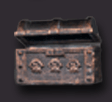







Foot Tiles Version
1.0
By Jeff Hogg
Foot Tiles are modular terrain sections for use in tunnel settings. They are meant to portable as well as functional. Each foot tile is a 12" square piece of terrain for use in underground scenarios. The rules for creating them are a standard for creating modular terrain. There are several advantages to using standardized tile rules. The foremost of which is that each player can build terrain that is ‘favorable’ to his (or her) style of play. A player with a ‘shooty’ warband is going to want some areas with long corridors that he (or she) can take advantage of. A player with a ‘goon squad’ of hand-to-hand warriors is going to want lots of short hallways and areas roomy enough to set up a good skirmish line in. Both players can get what they want, provided they build it. Which points the way to another advantage of the foot tile standard. Every time a player plays against a previously unmet opponent, the challenge of the table’s layout is renewed. If both the players are playing warbands that prefer to kill at a distance, the foot tile standard will generate a table with lots of long hallways to shoot down (making both players happy). If both players are using warbands that go for getting ‘stuck in’, the table will be a labyrinth of turning hallways (again, making both players happy). If the players split in their warband fighting styles, the table will have elements of both. The last point in favor of using this standard is one of simple mechanics. If everyone is working off the same standard, then the Set Up rules for any scenario can take the standard into account as they are being written, allowing for a more robust cross-section of scenarios. By allowing part of the tabletop to use more traditional terrain a large underground gallery can be created. This would allow for a scenario that takes place in a Great Hall, Calendar Chamber, or Treasure Store Room and the corridors around it. In essence, the standard allows a ‘short- hand’ method of describing very complex areas of the underground setting.
Building the modular terrain for the Foot Tile Standard follows these rules. .
1) While it would be nice for each tile to be exactly 12" by 12", some allowance has to be made for the fact that the tiles are not likely to be perfectly square or sized. If the tile is fractionally under measured then it will still work fine. So the tile should be as close to 12" x 12" without exceeding that measurement. If there is to be fractional error, the must be fractionally LESS than 12".
2) All tiles are to be built with the exit/entrance points CENTERED on the tiles edges and all exit/entrances should be 2" wide. Again there will be some error in measurement but errors in the ‘doorways’ between tiles will not cause the table to ‘warp’ (so they are much less critical).
3) The minimum width for a hallway is 2". This allows two 20mm or 25 mm base models or one monster base model to effectively block a hallway and still leaves a little room to get your fingers in and move models without grazing them off of one another.
4) The measurement between the most distant exits MUST be no greater than 20". This is to prevent players from creating filigree labyrinths pieces that would take a dozen turns to cross and screw up time based scenarios.
5) No section of the tile can cause a ‘dead end’. Please note that if a pair of tunnels that cross ‘over and under’ each other, but never join is still acceptable.
6) Each player is required to have 8 tiles. Of the eight tiles, 5 of them MUST have four exits. The remaining 3 must have three exits.
7) The tiles may have terrain that builds ‘upward’, but the tiles height should never exceed 6" and the area of the ‘floor space’ may not exceed 216 square inches. This allows that a tile may be built that has a ‘second story’, but the area it covered could not exceed ½ of the ‘first floors’ area.
As long as the ‘terrain’ created adheres to these rules, the players may build on the tile as they choose. While I would like to see players create their own layouts in three dimensions by placing walls on the tile, drawing and coloring them would do. People who feel that their modeling/painting talents are limited could color copy or scan the tiles from WH Quest and paste them to the tile.
 |
|
||||
 |
 |
|
|||
|
|
|
 |
|
||
|
|
|
||||
|
|
|
||||
| |
|
||||
|
|
|
||||
| |
|
||||
 |
|
||||
| |
|
||||
| |
|
||||
| |
 |
|
|||
|
|
|
||||
|
|
|
|
|||
| |
 |
|
|||
| |
|
||||
| |
|
||||
| |
|
||||
|
|
|
||||
| |
|
||||
 |
|
||||
|
|
|
||||
| |
|
||||
|
|
|
||||